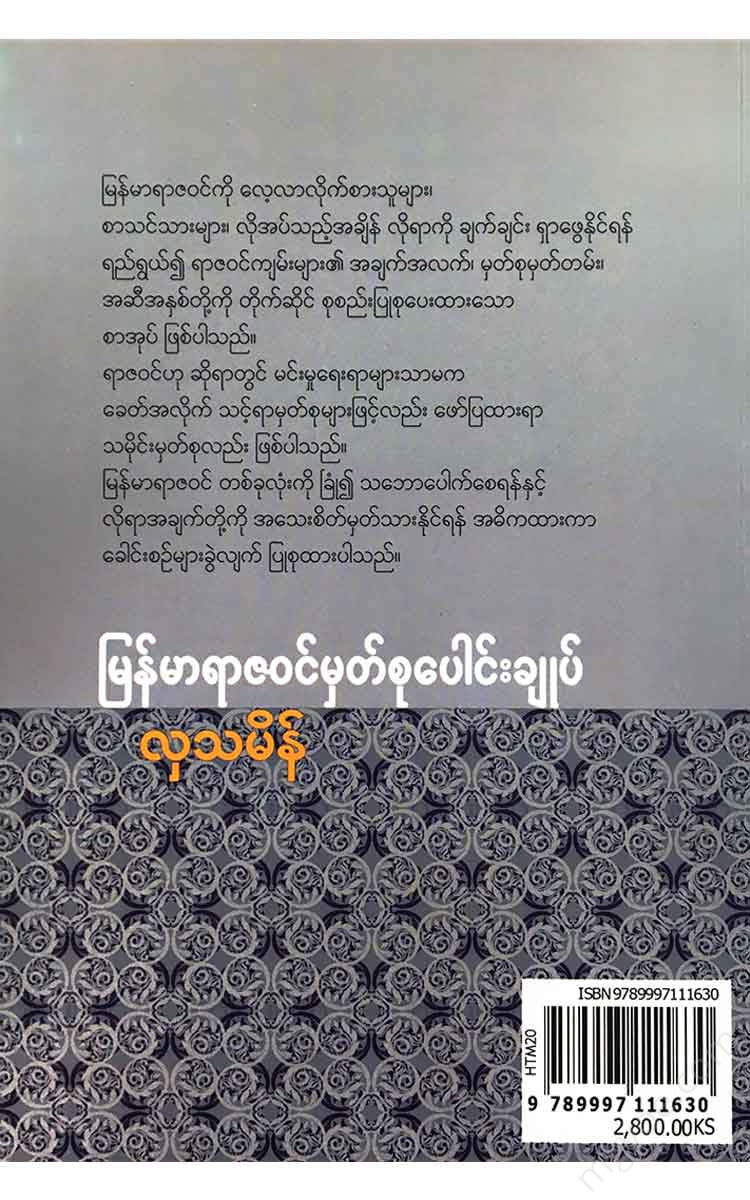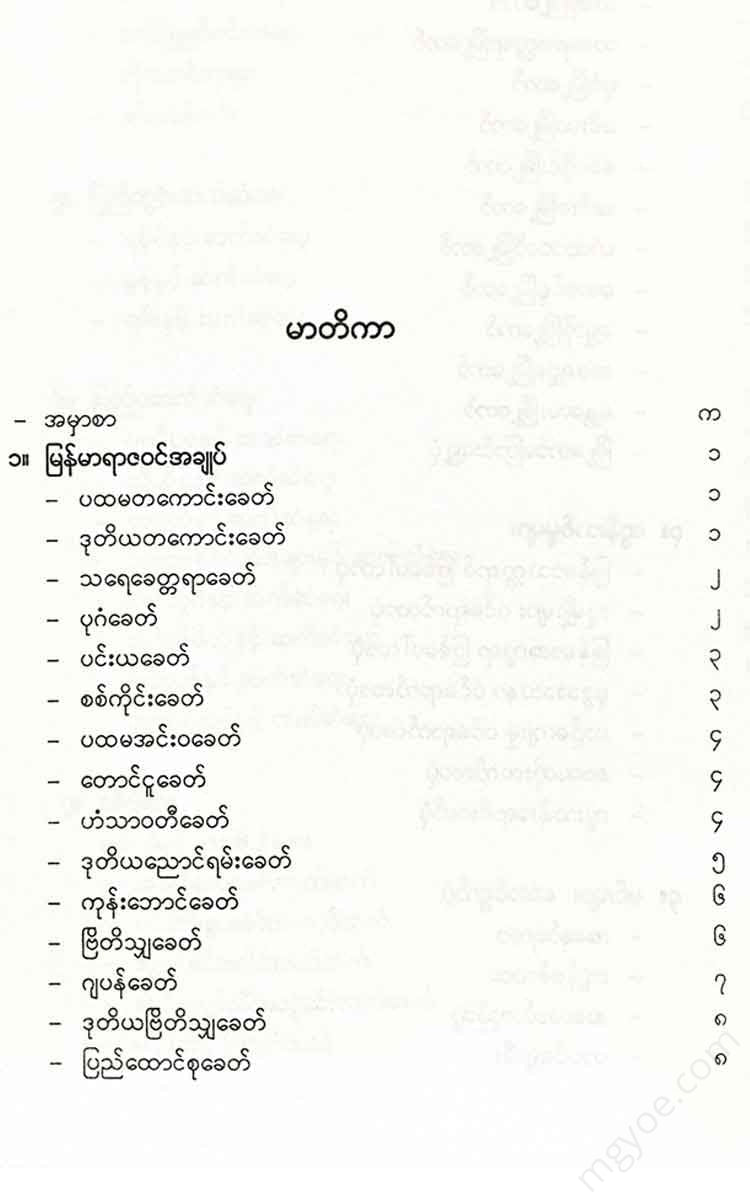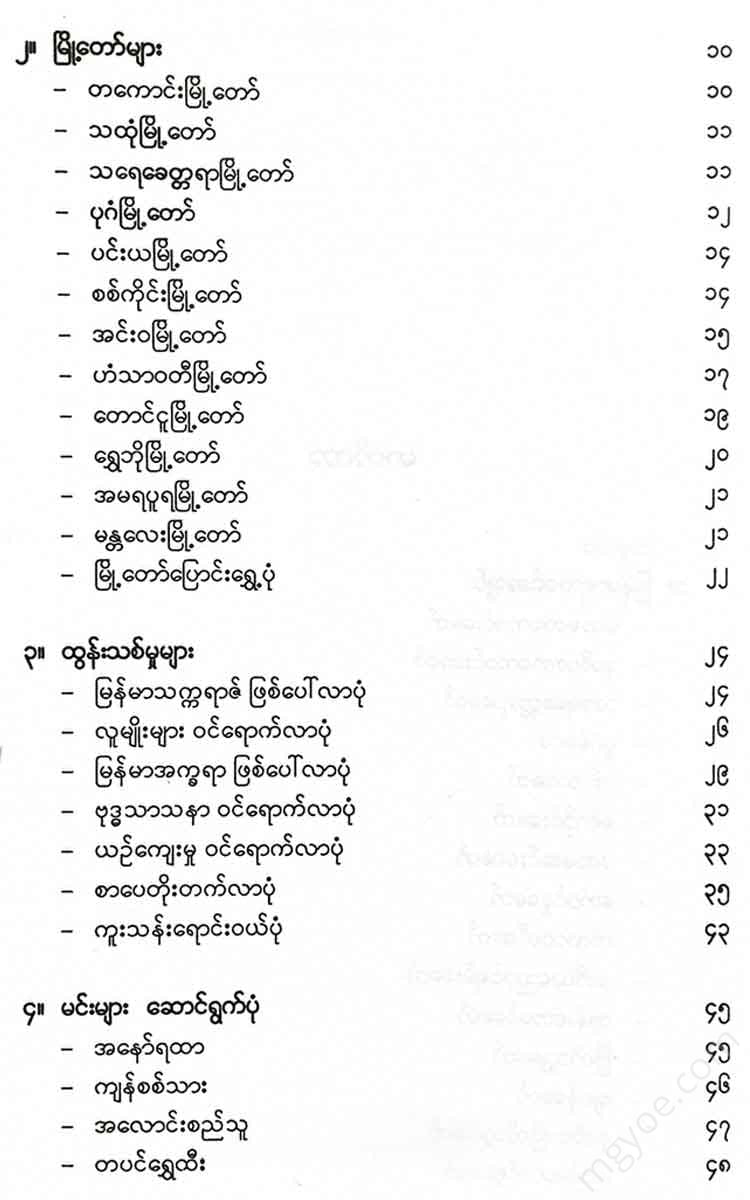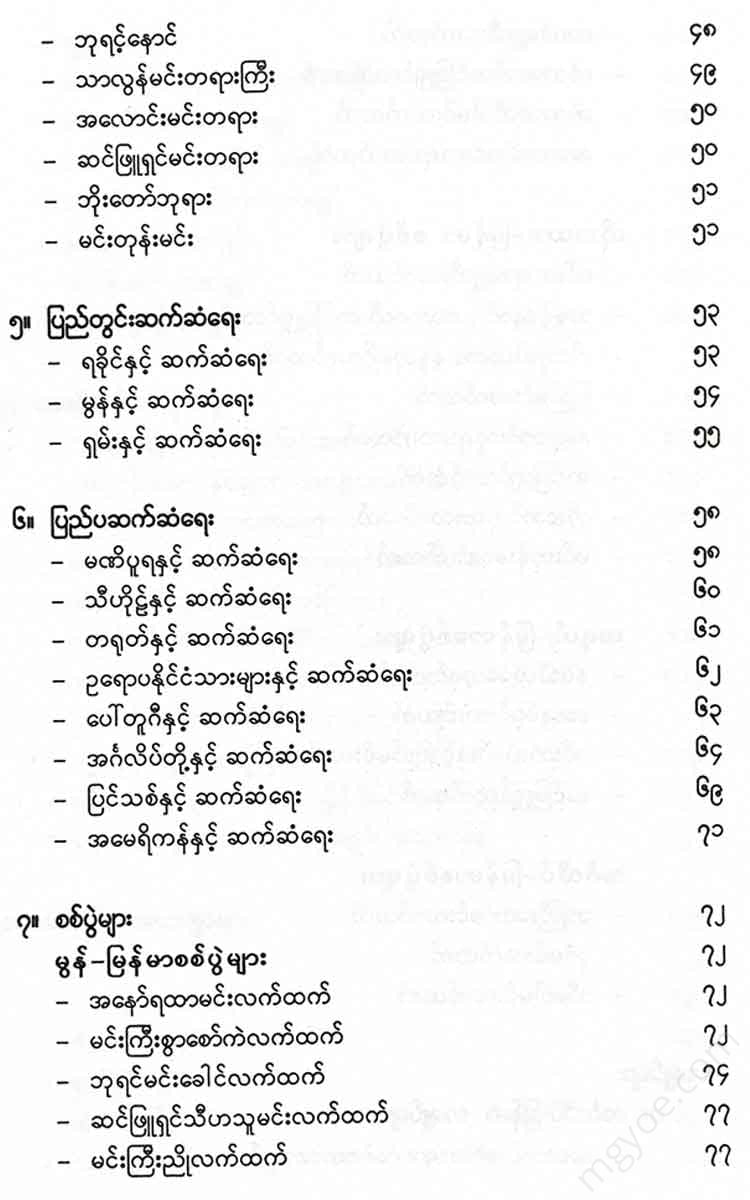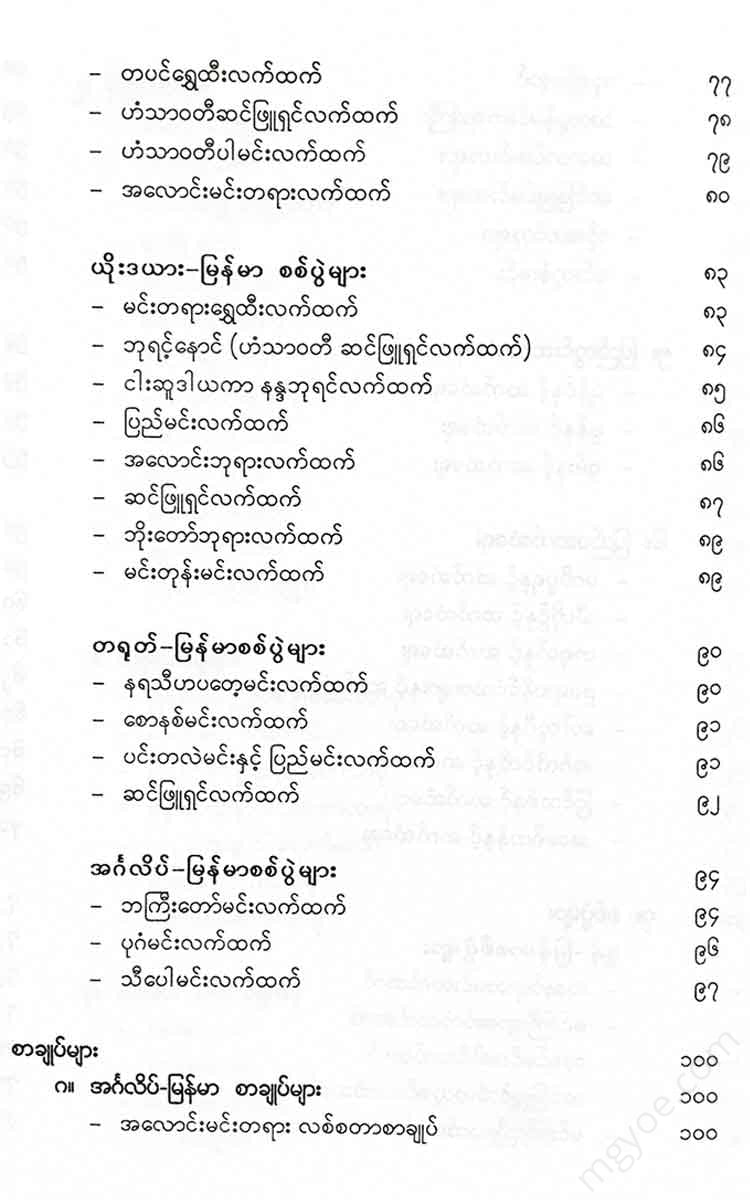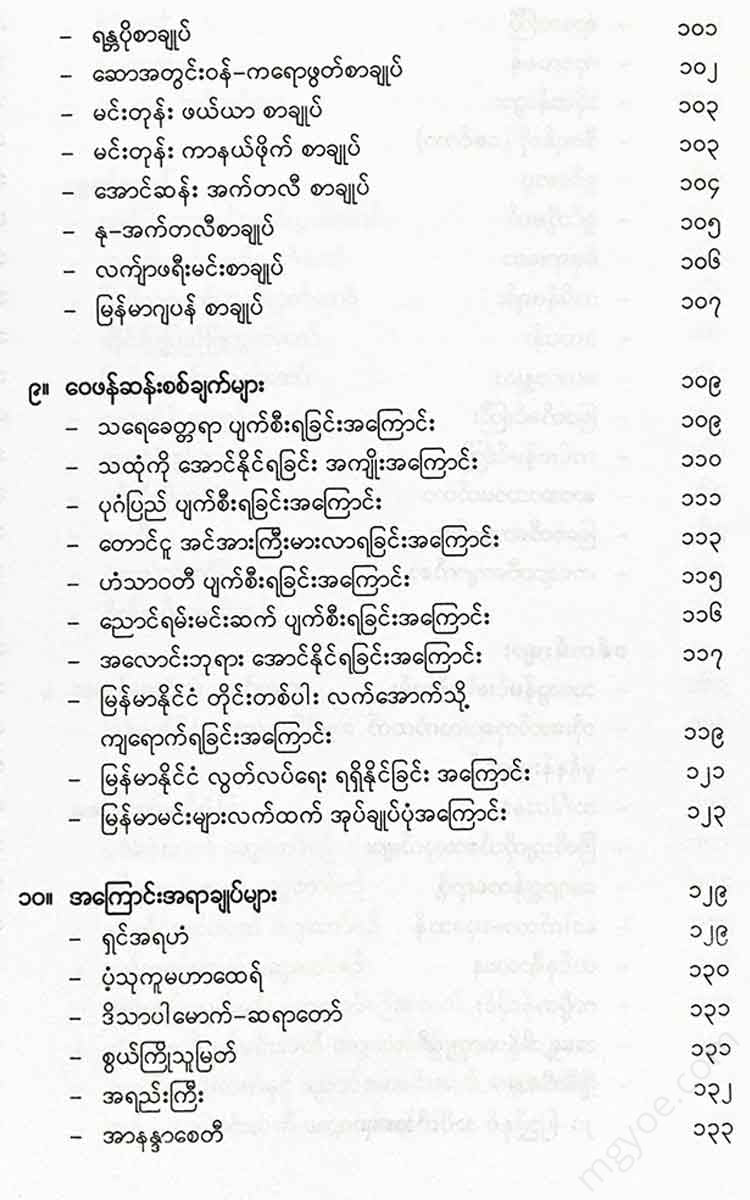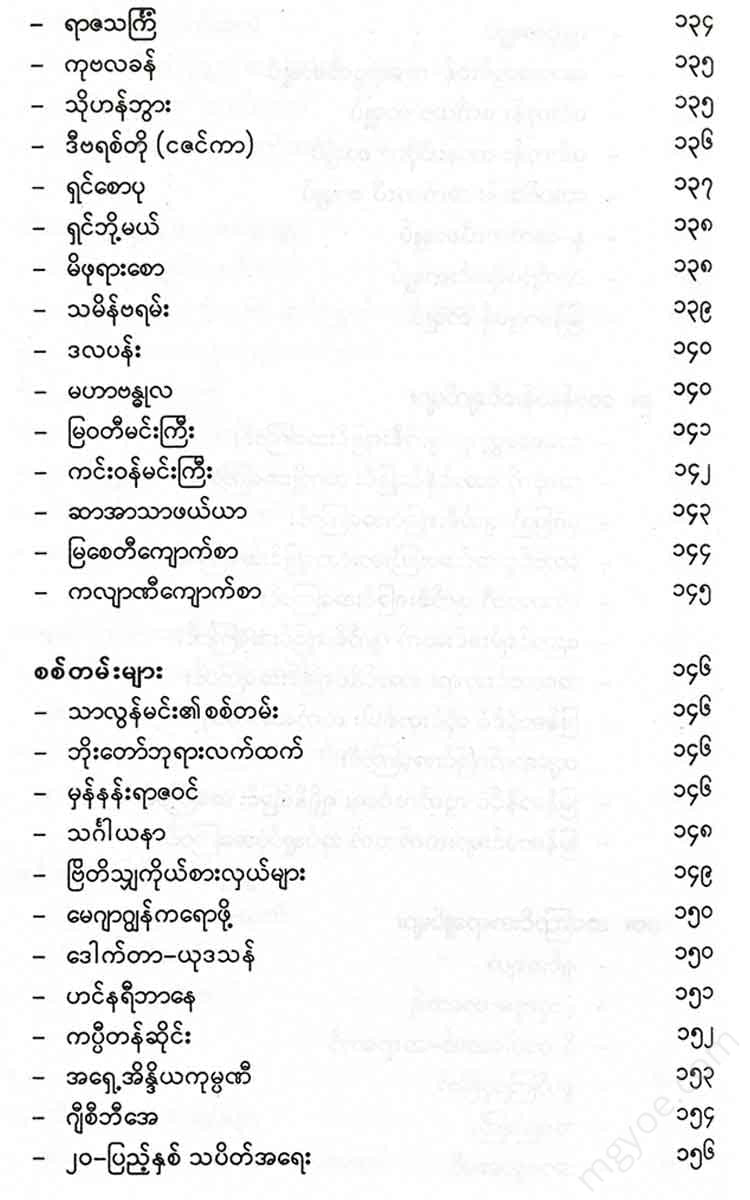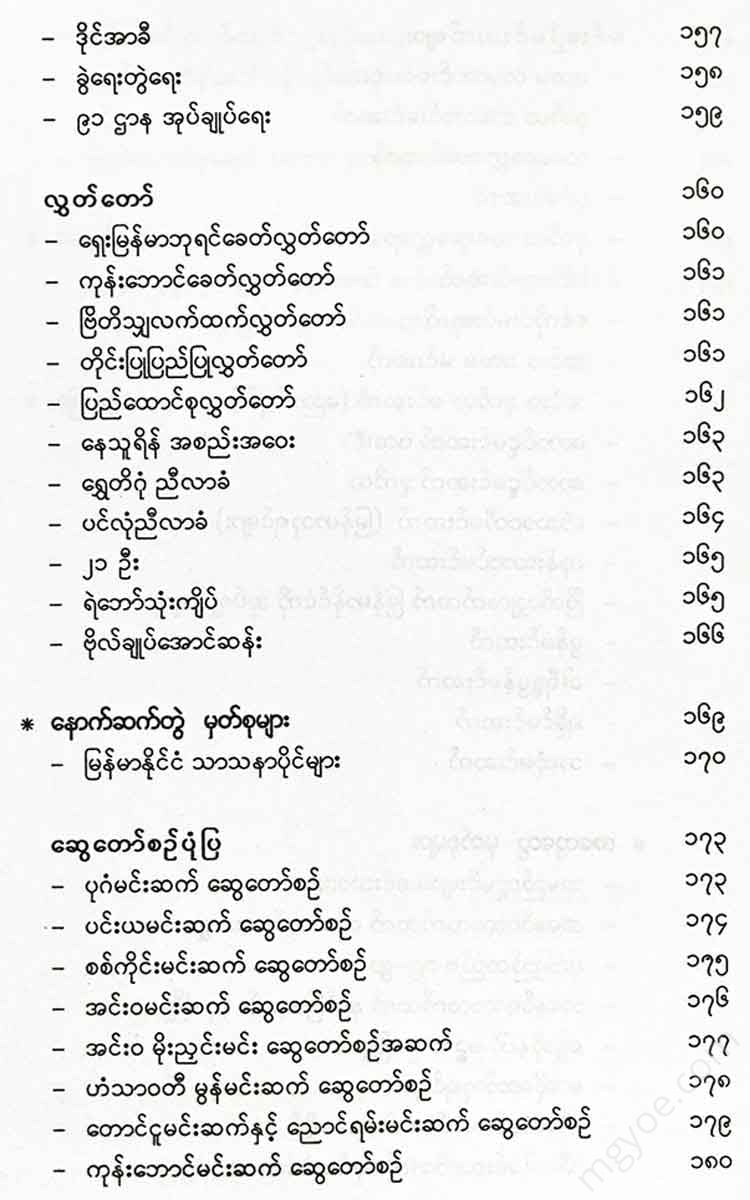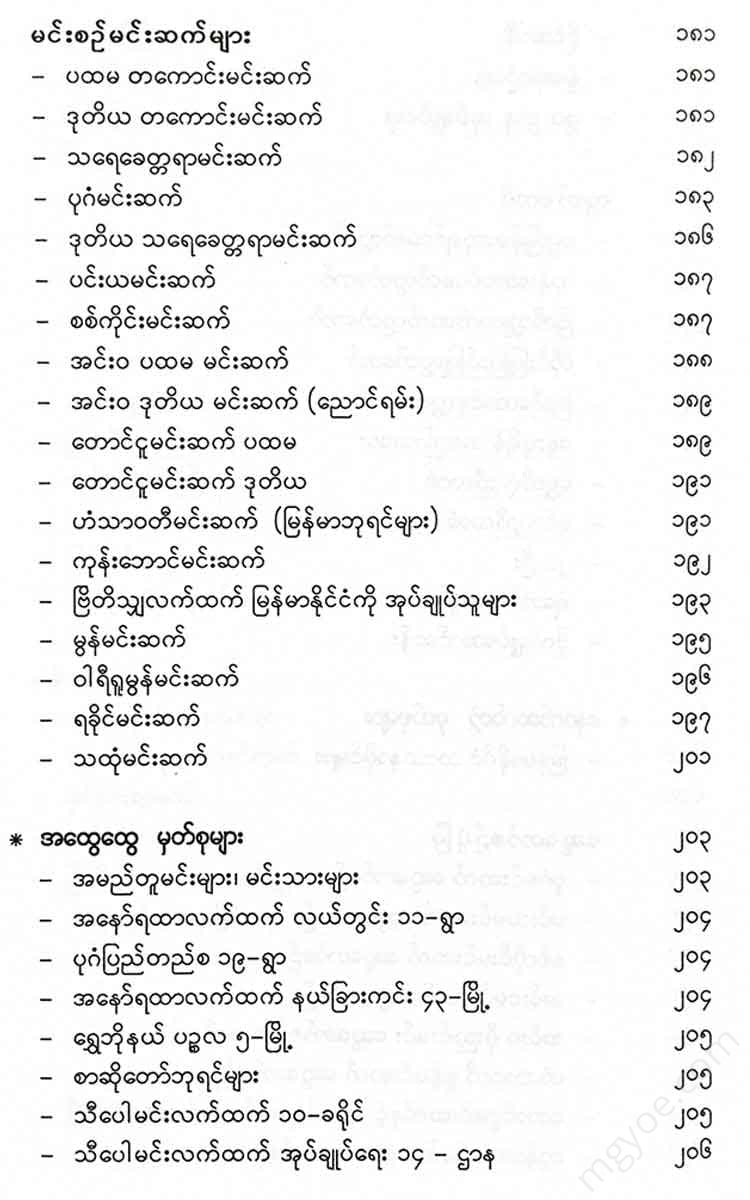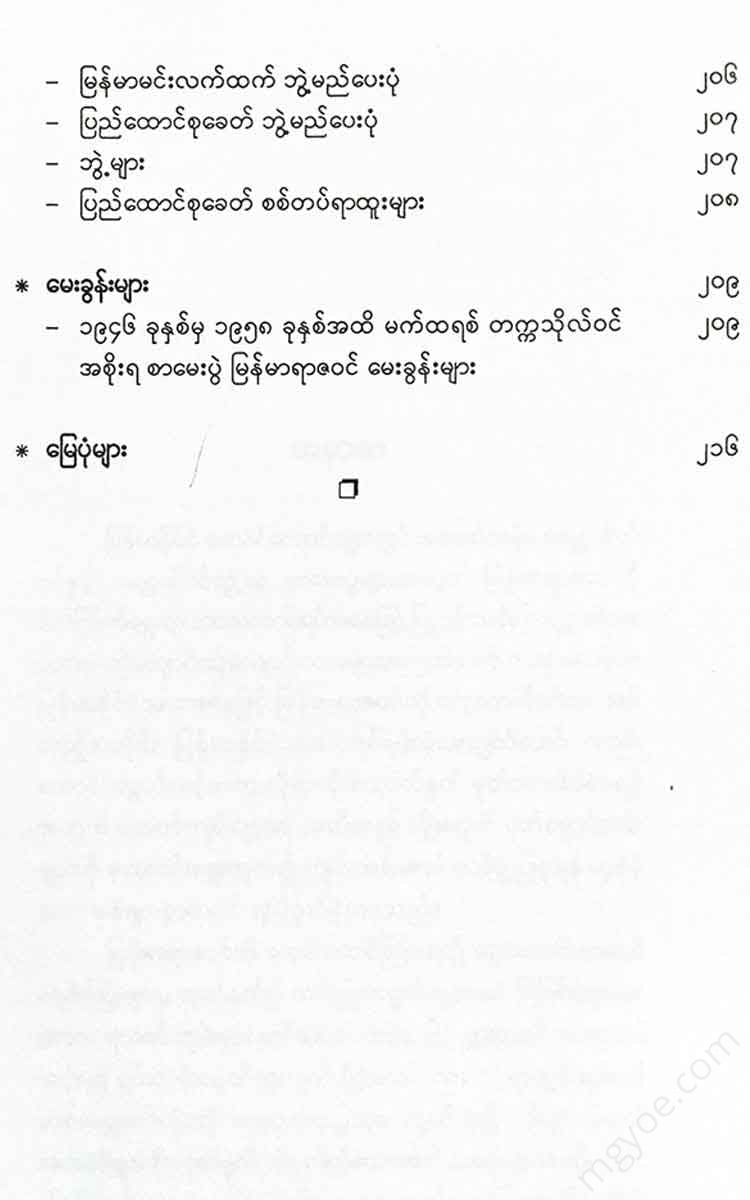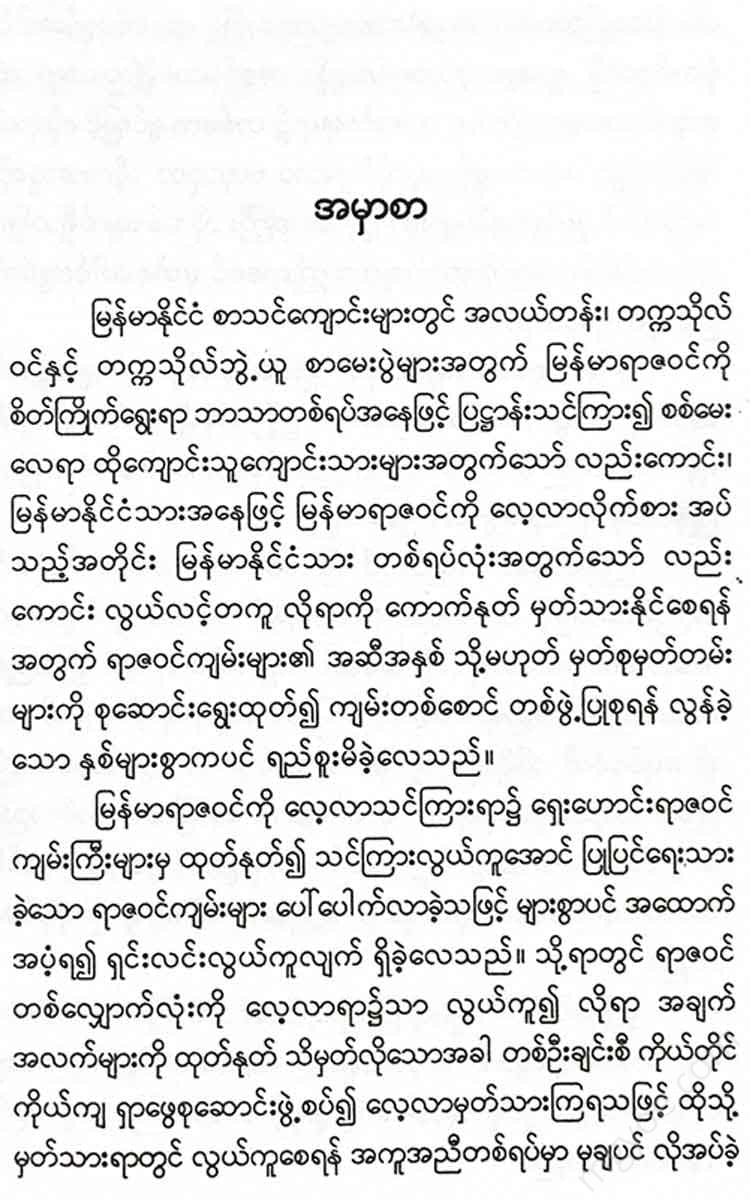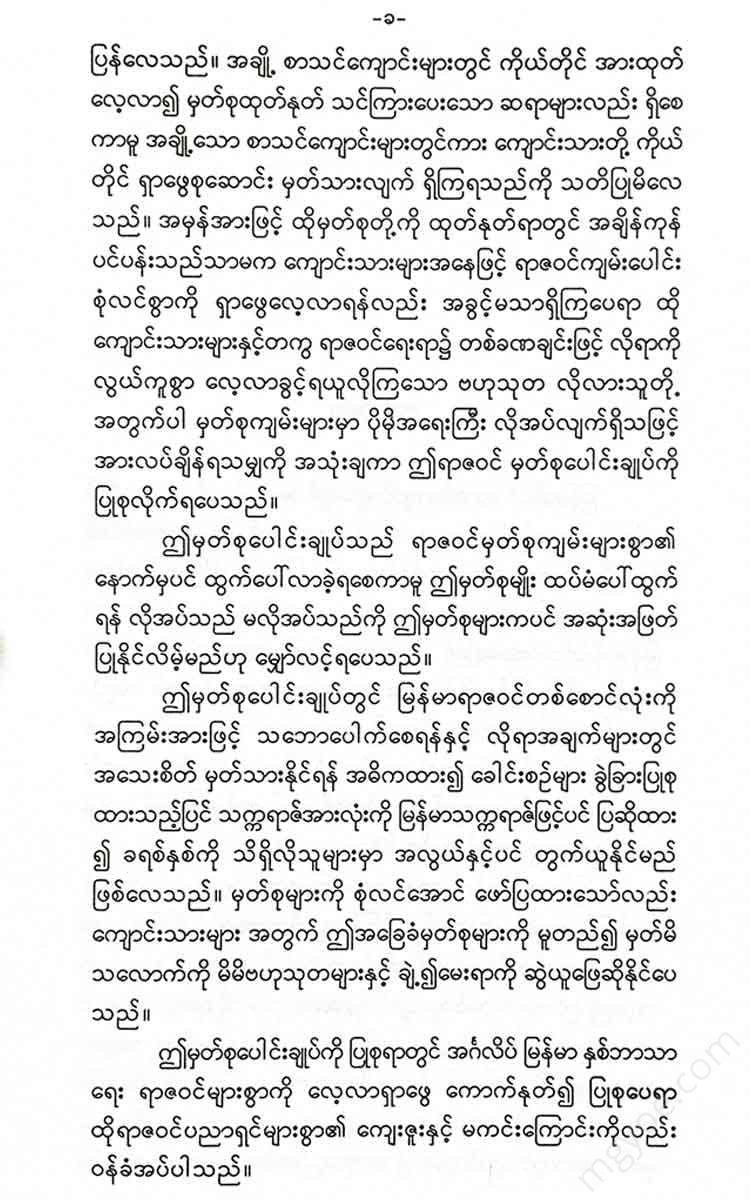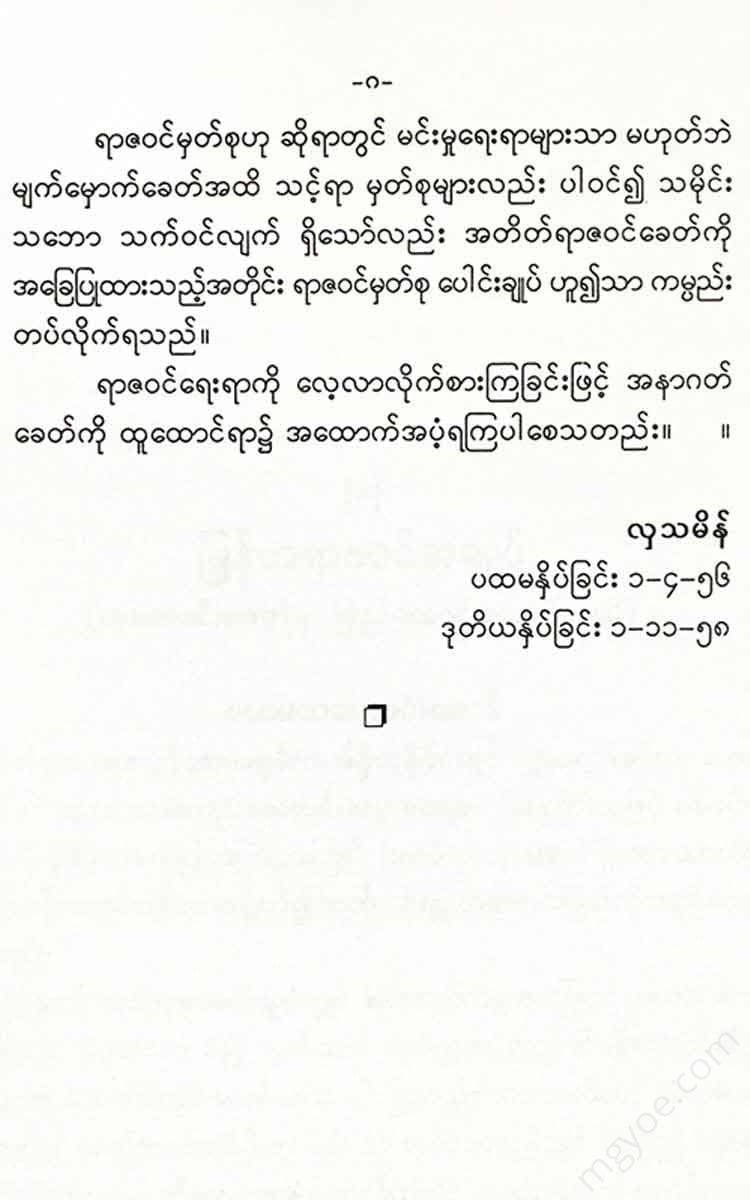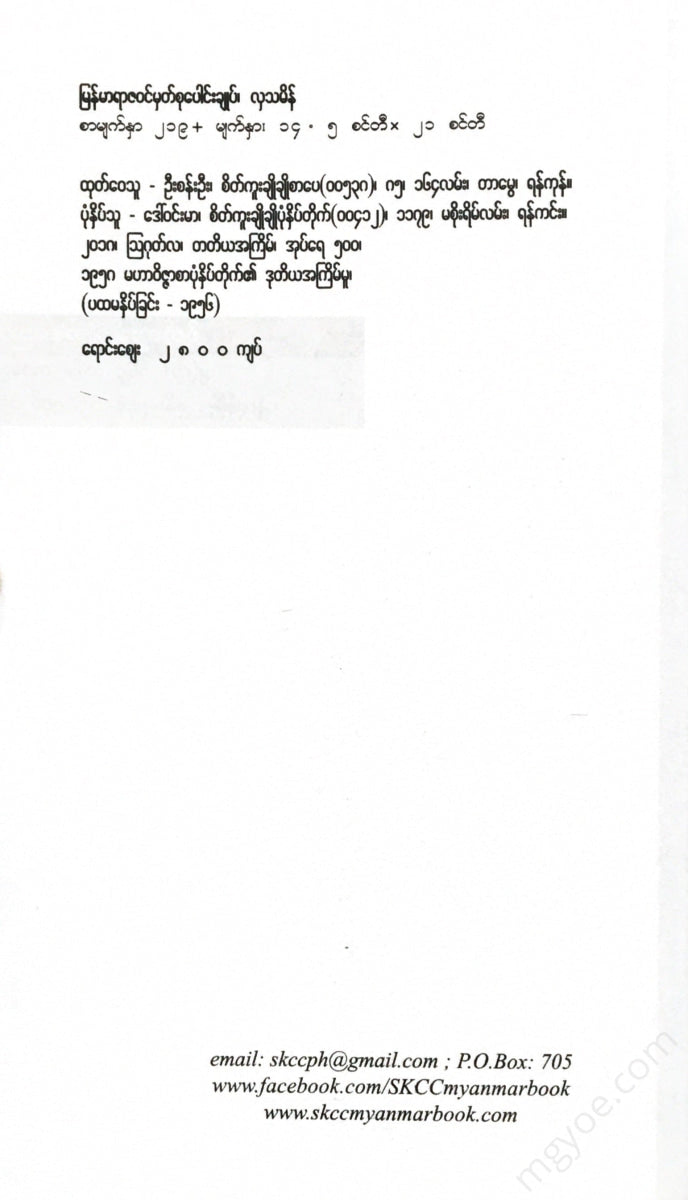စိတ်ကူးချိုချိုစာပေ
Hla Samin - A collection of Myanmar history notes
Hla Samin - A collection of Myanmar history notes
Couldn't load pickup availability
In the first Tagaung period, before the Buddha's enlightenment, the Panchasala king in India asked the Koliya Sakyan kings for a daughter, but they were not satisfied. They fought a war, and the Sakyans were defeated and scattered. A Sakyan king named Abhiraj came to Myanmar and established the kingdom of Sankasaraththa Tagaung.
After the death of Abhiraj, his son, King Kamraja, named his younger son Taungnyo as the king. His son, Mudusitta, established the city of Kyaukpadaung and continued to rule in Dhanyawaddy. His younger son, King Kamraja, continued to rule in Tagaung. After 33 generations of kings, King Gandhara of the Sein kingdom attacked and destroyed Tagaung during the reign of King Binnakara.
Second Tagalog era
During the time of the Buddha's enlightenment, King Pashana of Kosala of Savatthi asked King Mahanama of Kapilavatthu for a daughter, but instead of giving him a real princess, he gave her a maid. He made that maid his queen and gave birth to a son, Vithaba. When the son grew up and went to Kapilavatthu, he did not treat the prince as a slave, and if he became king, he would be destroyed and the Sakyans would flee. At that time, a Sakyan king named Dharaja was establishing the Maurya city in Rakhine. When he entered Burma, he met Nagasena, the queen of the last king, the first Tagaung king, and established Anyabagana.
Then, after giving birth to his son, Viraja, he first renamed Tagaung as the fifth kingdom and took the title of Thodo Jambudi Padja. He ruled from that time on, and the last king, the 17th Thodo Mahamin, had no children and appointed his brother-in-law Kepaduta as the king. In the 40th year of the religious year, Kepaduta followed the great boar and reached the place where Sri Ksetra was to be built.
He did not return when he arrived, but became a hermit. Later, he gave birth to two blind sons by the wife of King Thato, but his father did not like it and hid them. When he was 20 years old, he found out and had them floated on a raft.
On the way, the princes were healed by the demon Sandamukhi, who gave them sight, and they met Uri Rathe's daughter, Vedaari. In the 60th year of the religious year, with the permission of Uri Daw, she married her elder brother Mahasambhava, and they established the city of Sri Keshta and reigned.
Sri Keshtara era
In this way, the Pyu in the Sakya region were ruled by Mahasambhava. Six years after Mahasambhava passed away, his brother Sula Sambhava took Vedarī as his wife and gave birth to his son, Prince Duttapao. Prince Duttapao ruled after his father died. As usual, in the 27th century from Mahasambhava, during the reign of Sugyannanagarasinda, the 27th king of the 27th dynasty, the people fled in fear and the country was destroyed. That year was the 16th year of the Sasana.
Pagan period
Then, 13 years later, in the 29th year of the Sasana, the nephew of Sugyannanagarasinda, Prince Samutiraja, also established a city in the area of Yonhluttaw Island, and during the reign of Pyusawhti, the third king, the city was named Arimaddanapura.
Then, during the reign of King Thein Lan Kyaw, he established a second new city of Bagan under the name of Sri Pisaya in the Lokananda area and continued to reign.
Then, during the reign of the 12th king, Thaykhtaing, he established a third new city of Bagan called Tampawaddy at the site of the village and continued to rule.
Then, during the reign of King Paynpya, the 34th, Punnagama IV established the new city of Bagan at the site of Nagasang village and continued to rule. In the year 645 of the Bagan era, during the reign of King Narathihapat, the 52nd, the Chinese attacked and the king himself had to flee to Pathein. Bagan was also almost destroyed. Then, when the Chinese returned, Narathihapat was assassinated by his son Thihathu on his way back to Bagan and died in Pyay. Then, when Thihathu died, Narathihapat's younger son Kyaw Swar returned to Bagan and ruled.
After Kyaw Swar, his son Saw Ni and grandson Saw Mon Ni continued to rule. However, Bagan was no longer prosperous, and the Shan Theingkhabo's son Asinkhaya Raja Thingyan and the Thiha clan, who had been promoted during the reign of Narathihapat, were competing for power in the cities of Myin Sai, Makhra, and the sea. In the Bagan era, the dynasty ended in 730 and later became subject to the kings of Pinya, Sagaing, and Inwa.
Pinya period
The three Shan brothers ruled three cities at the same time, but after 5 years, the Thingyan festival came to an end. Thihatu killed Asankaya and left him alone, and in 672 AD he founded and settled in Pinya. Then, in 726 AD, during the reign of the 6th king Uzana Bawn, the Minmyo dynasty, which founded Inwa, attacked and captured Pinya, destroying it.
Sagaing era
The Sagaing period was contemporary with Pinya. Pinya Thihatu had 4 sons, and he gave Sagaing to the youngest, Asinkhaya Saw Yun, and made him king. From then on, there were 7 kings in Sagaing, and in 726, during the reign of Min Pyak, Thatoe Min attacked and destroyed Sagaing.
First Inwa period
Near the end of the Pinya and Sagaing periods, the Sagaing prince Saw Yun Mya, a descendant of King Tagaung, founded the city of Inwa in 726 CE. From then on, during the reign of the 13th Inwa king, Narapati, the Shans attacked in 888 CE, and the Shan king Tho Hanbwa continued to rule.
After the assassination of Tho Han Bwa by a Burmese minister named King Yan Naung, he installed Ohn Baung Khon Mhai as the king. Then, Thar Moe Bwe Narapati, then Sithu Kyaw Htin, and Sithu Kyaw Htin continued to rule, and in 916, during the reign of Sithu Kyaw Htin, Bayint Naung, the White King of Hanthawaddy, attacked and captured the kingdom.
Taungoo period
The Taungoo Dynasty, which is the beginning of the Hanthawaddy Dynasty, should be mentioned first. The Taungoo Dynasty was established in Taungoo by the descendants of Anantathuriya, the younger brother of the king, during the reign of Narapati Sithu, the 48th king of Bagan. It was a period that coincided with the Bagan period, the Pinya period, the Sagaing period, and the Inwa period.
The 29th King of Taungoo, King Nyo, was a rival to the throne of Inwa Shwe Nan Kyaw Shin. Shwe Nan Kyaw Shin fought against Taungoo but was unsuccessful.
Then, when the Shan attacked the Golden King of Inwa and captured Inwa, the Burmese from Inwa took refuge with King Nyo of Taungoo, and Taungoo became strong. When King Nyo died, his son Tabin Shwe Htee ascended the throne. When Tabin Shwe Htee died, King Sinphyu of Inwa, Bayintnaung, ascended the throne and defeated the King of Inwa, Sithu Kyaw Htin. Then Inwa fell under the control of King Sinphyu of Taungoo.
Hanthawaddy period
After the Hanthawaddy city was established by the brothers Samala and Vimala during the Hanthawaddy period, and after the decline of Hanthawaddy during the reign of King Tissa, the 17th king, the Wari Rumon Dynasty was established in 643 by competing with the Taungoo Samayun and the Bagan Chinnagun.
After that, in 715, during the reign of the 7th Banya U, the new city of Hanthawaddy was established and the Mon kings continued to rule. In 899, during the reign of the 11th Banya Sushin Takarutpi, the Taungoo king attacked Tapin Shwe Htee and the Mon dynasty was ended. Tapin Shwe Htee died. Min Ye Thein Khathu and then Thihathu continued to rule in Taungoo. Bayintnaung, who succeeded Tapin Shwe Htee, established the new city of Hanthawaddy and ruled in 928.
During the reign of King Bayintnaung of Hanthawaddy, his brother Thatoe Min Saw was appointed as the governor of Innwa. Thiha Tu was promoted in Taungoo. When King Bayintnaung died, his son King Nanda continued to rule in Hanthawaddy. In 960 CE, King Min Raja of Rakhine joined forces with the King of Taungoo and attacked Hanthawaddy, causing the Hanthawaddy dynasty to fall and end.
The Second Nyaungyan Era
Even before the fall of Hanthawaddy, Bayintnaung's son Min Ye Randa Meik had gathered people in Inwa and was already ruling in Inwa in 995. After Bayintnaung captured Inwa in 916 during the reign of Sithu Kyaw Htin, Inwa was ruled by Thato Min Saw, then La Kyaw, son of Tabin Shwe Hti, and then Min Ye Kyaw Swar, son of King Nanda of the Five Sudayakas. From 955 to 959, there was no king, and it only became prosperous when Min Ye Randa Meik began to establish himself. After the fall of Hanthawaddy, the Nyaung Ram dynasty came to dominate the entire country of Myanmar.
After Min Ye Ranta Meik, there was peace until the reign of the 10th Mahadhamraja. During the reign of Mahadhamraja (Hansawaddy Pa-min) in 1113, the Mon from Hanthawaddy attacked and destroyed the second Inwa.
First, after the fall of Hanthawaddy during the reign of King Nanda, it was under the control of Inwa, and in 1102, Monsamein Htaw and Banyadala took over and even attacked Inwa. However, in 1119, they were suppressed by Alaungpaya from Shwebo.
The Konbaung era
During the Second Inwa period, the Mons invaded and destroyed Inwa. However, Alaungmin Dhamma U Aung Zeya, a descendant of Inwa Moehnyin and Pyisung kings, fought against the Mons from Shwebo, Konbaung, and established a capital in 1115. He eventually conquered Hanthawaddy and established the Konbaung dynasty.
The Konbaung dynasty was ended by the British in 1247 during the reign of King Thibaw, the 11th successor to King Alaung.
The British invaded Burma three times, and in 1187, during the reign of King Bagyidaw, they had to cede Manipur and Kachar, and the British took over Rakhine and Tanintharyi. In 1214, during the reign of King Bagan, they had to cede the lower Burma of Bago, and in 1247, during the reign of King Thibaw, they took over the entire country.
British era
After the British annexed Burma, the government was changed to a Lieutenant Governorship in 1859, and the first legislature was established under Section 39 of the Indian Legislature Act, 1861. All nine members of the legislature were appointed by the Lieutenant Governor.
Under the 1271 Mintomoli Reforms, only 15 of the 30 members of parliament could be elected from the country. Then, under the Indian Act of 1277, 28 members could be elected. However, under the 1281 Act, Burma was governed by a system of division of power between the people and the government (diarchy) from 1285. From then on, Burma was transformed into a country ruled by a governor.
Then, in 1299, Burma was separated from India and administered separately with 91 departments and a bicameral parliament consisting of 132 members. From then on, Burma remained governed in the same manner until the Second World War in 1309.
Under the British rule, since 1237, Burmese heroes from various regions have been fighting for independence, and the British have been constantly protecting them. Then, in 1273, they formed groups and made small efforts for independence. In 1281, Burmese representatives were sent to England to start agitating. They went to England many times to appeal, but nothing changed. In 1282, a student strike broke out. In 1292, a peasant uprising led by Saya San broke out for independence. In 1300, a student, worker, and farmer uprising broke out again. The spirit for independence was strong.
In 1902, Japan declared war on Britain and the United States, and Burma entered the Asian arena of World War II. Before that, General Aung San and thirty comrades from Burma secretly went to Japan, trained in military skills, formed the Burma Independence Movement through Thailand, and entered from Tanintharyi with Japanese help. During the reign of Governor Sir Dorman Smith, British troops gradually withdrew and finally abandoned Burma.
Japanese era
Since 1304, the British had helped Japan to occupy Burma, and then they pretended to be independent and ruled under a fascist system for 3 years. In 1307 (27-3-45), General Aung San and Burmese patriots had to systematically fight back. At that time, the British allies entered, Japan surrendered and World War II ended, but they continued to occupy Burma.

